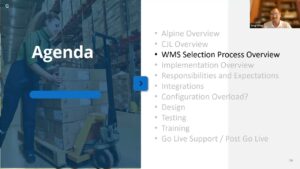Our partners over at Made4net were named to Gartner’s Magic Quadrant for Warehouse Management Systems for a 9th year in a row, congratulations! Please read the blog post by Mad4net below, outlining their key takeaways of the Magic Quadrant, as well as a link to download the report.
Made4net is proud to announce that we have been recognized by Gartner in the 2024 Gartner® Magic Quadrant™ for Warehouse Management Systems (WMS). This is the ninth consecutive year that we have been recognized for our Ability to Execute and Completeness of Vision.
‘’Gartner started the process for this research by considering over 80 WMS providers, but only the 20 vendors featured provided the evidence that they met the documented inclusion criteria.’’ The following are few of the criteria included in the report:
- Credible WMS product supporting core and some extended capabilities
- Vision for WMS in moderately complex warehouse environments
- Combined WMS license/subscription and services revenue of greater than $25 million for the previous 12 months
- Modest global presence with at least 10% revenue and customers outside home geography
- Independent WMS offerings, sold and implemented separately from non-software related services or products
As stated in the report, “Although functionality remains the number one user evaluation criterion, there’s near-functional parity for basic core WMS capabilities across WMS providers.” Fact is, today’s users are looking for more than functionality. ‘’Technical architecture as well as vendor and product viability, TCO and time to value, have become increasingly important criteria, almost on par with the importance of functionality. ‘As basic core WMS has approached parity in the market, implementation tools and methodologies, as well as integration with other applications, have become more important considerations in customer evaluations.’’
We recently sat down with Amit Levy, Made4net’s EVP of Sales and Strategy, for his view on our key takeaways from this year’s Gartner Magic Quadrant for WMS and what’s important to today’s WMS buyers.
Our Key Takeaways
#1 Labor challenges and rising costs are significant drivers behind investments in Warehouse Management Systems
According to Levy, “In recent years, we’ve witnessed a recalibration in warehouse and logistics processes, placing greater emphasis on innovations to address warehouse labor, capacity and visibility challenges. This underscores the importance of a robust platform that seamlessly integrates traditional labor with automation and robots, powered by AI.”
The report supports this view. “Customers now focus more attention on value-adding capabilities that surround core WMS capabilities, due to the compelling need to address labor shortages and rising costs. Examples include workforce management, task interleaving, slotting, yard management, dock scheduling and performance management. These have now become common requirements in all but the most basic WMS deals. Furthermore, labor shortages are motivating companies to consider various forms of automation – from intralogistics smart robotics to complex conventional material handling automations systems that are often found in Level 5 warehouse operations. Consequently, buyers are increasingly interested in how various WMS offerings will support and synchronize automation both now and in the future.”
#2 Integrating and optimizing workflows seamlessly across all stages of business operations is crucial for those purchasing Warehouse Management Systems.
Levy states, “A lack of integration and the inability of SCE solutions to work well together remains a challenge for many organizations today.” As per Gartner, ‘customers increasingly favor solutions that can support end-to-end supply chain and logistics process orchestration. Gartner refers to these areas as supply chain convergence and supply chain execution convergence (related to convergence of operational activities).
Levy also shares “Nowadays, just managing inventory and movements in the warehouse isn’t sufficient for a WMS solution. The aim is to synchronize data with all other supply chain execution systems, such as a TMS, and optimize activities around constraints across the entire supply chain.”
According to the report, this year’s vendors were indeed evaluated on how well they understand the emerging concept of Supply Chain Convergence and what strategies they have in place to move in this direction.
#3 A growing number of WMS implementations are cloud-based solution deployments.
“Maintaining on-premise solutions can be time-consuming, expensive and risky. There’s hardware and software to invest in upfront, time to install and test all solutions, required maintenance to ensure the infrastructure’s continued operation, numerous IT security measures to take, and more. For this reason, cloud WMS solutions make more sense for a growing number of companies,” says Levy.
The Gartner Magic Quadrant for WMS shares, “Cloud has become the preferred WMS deployment option, with more than 80% of new customers preferring cloud if the economics are reasonable.”
Cloud-based WMS are here to stay.
#4 Today’s WMS buyers require software that can be easily and quickly customized to their needs.
The report states, “Both vendors and Gartner end user clients have reported continued constraints on WMS implementation resources, driving organizations to look for other forms of support and innovation in deployment approach.”
Levy agrees. “Maximum user configurability, and minimal need for additional professional services is more attractive to today’s WMS buyers than ever before. Made4net offers a flexible, rules-based, customizable platform with proven, industry-specific templates to ensure customers don’t have to start from scratch. This workflow-based application allows customers to configure rather than code, which shortens the path to implementation and reduces the need for technical resources. We believe this is a main reason many customers choose to partner with us.”
#5 Technical architecture, TCO and time to value are important evaluation criteria.
The report notes that while WMS buyers continue to place emphasis on product breadth and depth, vendor expertise, and customer service and support in WMS evaluation, “Technical architecture as well as vendor and product viability, TCO, and time to value, have become increasingly important criteria, almost on par with the importance of functionality. As basic core WMS has approached parity in the market, implementation tools and methodologies, as well as integration with other applications, have become more important considerations in customer evaluations.”
Levy agrees, “I believe that this is another great example where configurability on a common platform provides tremendous value through a streamlined set up and implementation process and a better overall fit for the customer’s distribution processes. Our standard implementation timeframe is 20 weeks, whereas other vendors can take nine months to a year, or longer.”
#6 WMS buyers want to keep it simple when possible.
According to the report, “The focus on breadth and depth of WMS offerings remains valid for the most sophisticated operations, while other factors such as simplicity, usability and cost of ownership are more important in the less-complex environments. However, we continue to see a divergence in the WMS market between the high-performance, complex and sophisticated end of the market and the mass market, we’re functionality needs only to be “good enough.” This is not because companies choose to sacrifice functionality. It’s because globally, the preponderance of warehouse operations are Level 3 or below in Gartner’s warehouse complexity model. Gardner defines Level 1 as the most basic warehouse operation and levels 4 and 5 being the most complex and automated. Warehouses at Level 3 and below do not require, nor would they normally use, the most advanced functionality.”
Levy shares that, “Most of the reputable WMS vendors are going to be able to handle all of the basic functionality you need, and most likely they will enable you to improve how you’re performing today. But many of these vendors will provide more functionality than you need which means you will probably only use about 50% of the available functionality. Having a good understanding of your warehouse complexity is key as more complex facilities require more WMS functional breadth and depth to support their needs, while less complex operations often require less functional robustness. You don’t want to overbuy or underbuy.”
Get Your Copy of the 2024 Gartner Magic Quadrant for WMS
The Gartner Magic Quadrant for Warehouse Management Systems is an essential resource for any company in the market for a WMS. Supply chain technology leaders can leverage this research to grasp the current state of the WMS market and gain important insights about recognized vendors . We invite you to learn more by downloading your complimentary copy today.
Disclaimer:
GARTNER is a registered trademark and service mark of Gartner, Inc. and/or its affiliates in the U.S. and internationally, and MAGIC QUADRANT is a registered trademark of Gartner, Inc. and/or its affiliates and are used herein with permission. All rights reserved.
Gartner does not endorse any vendor, product or service depicted in its research publications, and does not advise technology users to select only those vendors with the highest ratings or other designation. Gartner research publications consist of the opinions of Gartner’s research organization and should not be construed as statements of fact. Gartner disclaims all warranties, expressed or implied, with respect to this research, including any warranties of merchantability or fitness for a particular purpose.













